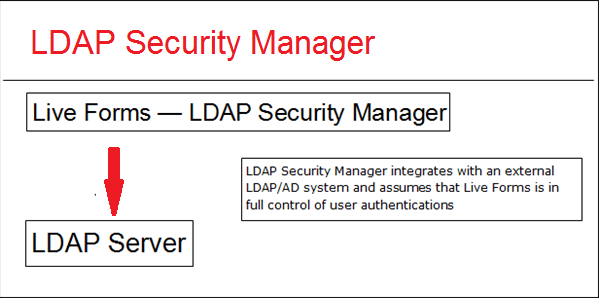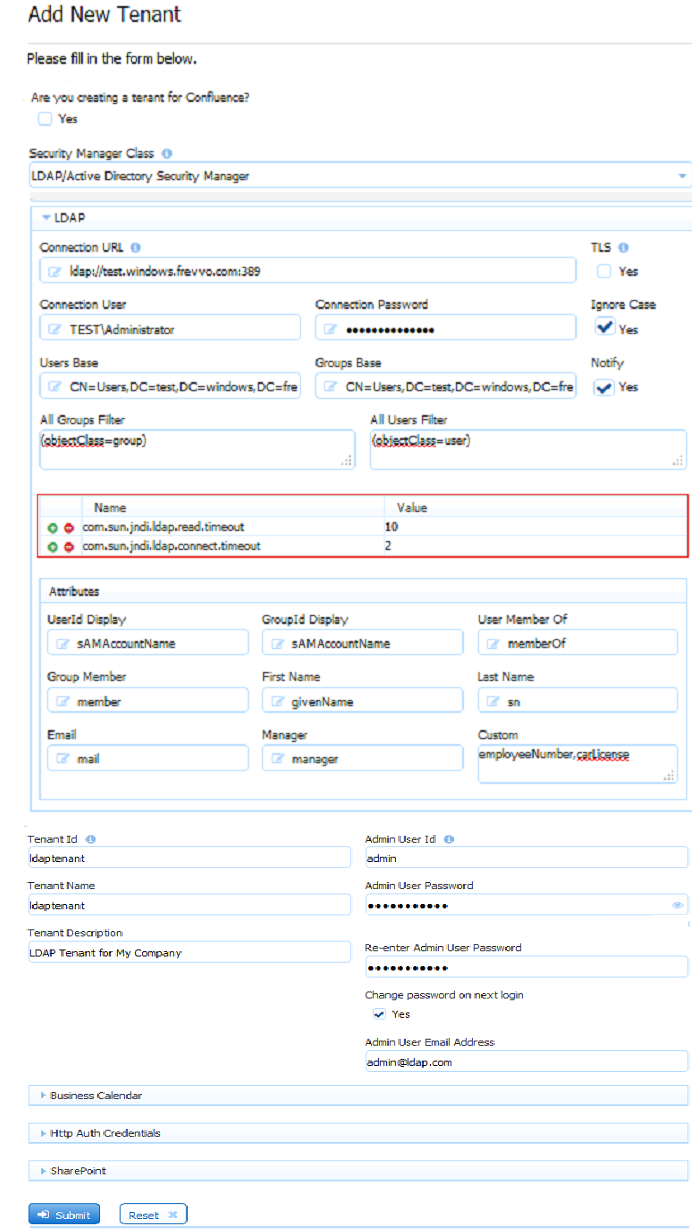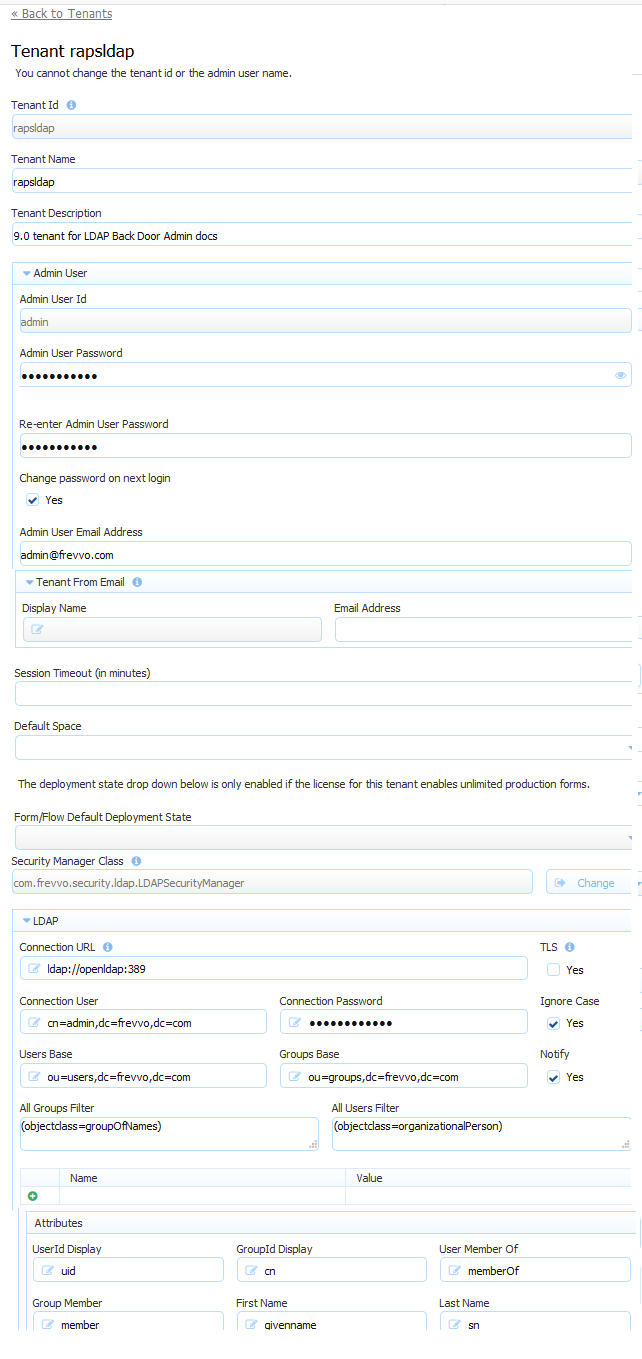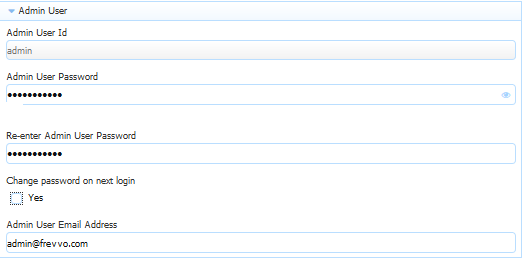| Section | ||||||||||||||||
|---|---|---|---|---|---|---|---|---|---|---|---|---|---|---|---|---|
|
...
Active Directory Customers using LDAP must ensure frevvo.TenantAdmin and frevvo.Designer groups are specified on your LDAP/AD server. The group names must be spelled as shown. Upper/lower case may be a factor for Open LDAP systems.
- Tenant admin users must be assigned to the frevvo.TenantAdmin group.
- Designer users must be assigned to the frevvo.Designer group.
| Warning |
|---|
|
Configuring and LDAP/Active Directory
...
- Login to as an administrator (user:admin and password:admin if you have not changed it)
- Click on Manage and then Manage Tenants
- You will see a page where the current tenants are listed. If this is a new installation you will only see the default tenant d
- Click on the plus icon to add a new tenant.
- Configure the new tenant - Choose LDAP Security Manager.from the Security Manager Class drop down.
| Section | ||||||||||||||||||||
|---|---|---|---|---|---|---|---|---|---|---|---|---|---|---|---|---|---|---|---|---|
|
Enter your LDAP Configuration Properties and Sample Configurations. Alternatively, you can start off from one of the sample configurations and provide only the key information listed above. See below for information on the TLS checkbox.
Note The Name/value table highlighted in the image allows you to configure up to 10 additional LDAP properties. See this Oracle website for a complete list of all available LDAP properties. For example, you can configure to ignore or follow referrals.
Setting the java.naming.referral property to a value of "ignore" in the Name/Value table configures to ignore referrals. Consult your LDAP Administrator for the details.
- If you are creating a new tenant:
- Enter a tenant id, a tenant name and description.
- The Max Concurrent Users is the maximum allowed by your license or less.
- Specify the User ID, password and email address of a user that will have the tenant admin permission. This user id is the built-in admin and can be used to access tenant administrative functions if you cannot log in as an authenticated LDAP tenant admin.
- The tenant admin id, password and email fields are required. The Change password on next login is optional. It is checked by default.
- Click Submit. You will see your new tenant in the tenant list if the connection to your LDAP server is successful.
| Warning |
|---|
The Ignore Case and Notify checkboxes are checked by default. It is recommended that you leave them checked. Refer to Mixed or Upper case User Names topic for an explanation of the Ignore Case option. The Notify checkbox determines whether the task notification emails setup in flows are sent or not. |
Clicking the submit button tests the connection. Any errors are displayed at the top of the form. Here is an example of an error when there is a typo in the LDAP server name:
Here is another example if the connection password is not correct
...
Since you are using LDAP to define users and roles (i.e., groups), you do not see an Add User icon or Add Role icon on the Manage Users or Manage Roles pages.
LDAP Built-in admin
A Tenant admin can login directly to frevvo or login with a user id who has been given tenant admin permissions in your Active Directory.
When you create a new tenant you are prompted to set up a tenant admin user id, password and email address. This tenant admin does not authenticate via your LDAP IDP. It only exists in frevvo. If you experience an issue with your LDAP configuration such that you can't login as an Active Directory authenticated user, use this account to login to your tenant as a tenant admin in order to fix your configuration issue. The built-in admin is able to access the tenant admin functions if your LDAP Server should become inaccessible. Only one built-in tenant admin account is supported.
Browse this URL to login as the built-in admin: <base_URL>/frevvo/web/admin/login. When specified, will prepend the base URL to the URLs in your Form/Document Actions. The <base_URL> is typically http(s)://<your servername>:<port>.
...
- Login as your authenticated LDAP tenant admin. Click the Edit Tenant link. The Admin User information is displayed .
- If logging in as the authenticated LDAP tenant admin is not possible, browse this admin specific URL - <base-url>/frevvo/web/admin/login. Enter the built-in admin userid. Click Forgot Password? Once you have changed the password, browse the admin specific URL again and login with the tenant admin user id and the new password. If you need to change the password again, or make changes to your tenant, click the Edit Tenant link. The built-in admin password can be changed on this screen.
This error message displays if any other user clicks on the Forgot Password? link after browsing the admin specific URL:
What if you do not remember the userid of your original tenant admin? Follow these steps:
- Login as your authenticated LDAP tenant admin. Click the Edit Tenant link. The Admin User information is displayed .
- If logging in as the authenticated LDAP tenant admin is not possible, the frevvo (Cloud customers) and in-house superuser can see the built-in admin tenant userid from the Edit Tenant page.
Secure LDAP Configuration
...
These are the properties used to configure the LDAP/Active Directory security manager. The properties in bold are required.
| Property | Description | Active Directory Sample Configuration | OpenLDAP Sample Configuration |
|---|---|---|---|
| Connection URL | ldap server url | In-house ldap://[your server]:[port, typically the default is 389 ] Cloud - SSL installed on your LDAP server ldaps://[your server]:[port, typically the default is 636] | In-house ldap://[your server]:[port, typically the default is 389] Cloud -SSL installed on your LDAP server ldaps://[your server]:[port, typically the default is 636] |
| Connection User | User to connect to LDAP. This user must have the proper permissions to read and run queries in the ldap server. If using Active Directory, it is common to specify the domain. Ex: an entry of TEST\Administrator refers to the user Administrator in the TEST domain. | [user name] | cn=admin,dc=test,dc=frevvo,dc=com |
| Connection Password | Password for the Connection user. | [user password] | [user password] |
| Users Base | Searches for users will start from the ldap node specified by this property.I f the value is empty the searches will start from the root domain. | CN=Users,DC=test,DC=windows,DC=frevvo,DC=com | DC=test,DC=frevvo,DC=com |
| Groups Base | Searches for the groups will start from the ldap node specified by this property. If the value is empty, searches will start from the root domain | CN=Users,DC=test,DC=windows,DC=frevvo,DC=com | DC=test,DC=frevvo,DC=com |
| UserId Display | User attribute that will be visible in frevvo. This is what will be displayed in the list of users a tenant admin sees and has to be unique in the server. Another restriction is that the values for the attribute configured here cannot have spaces. For instance, don't configure CN as the value since it can contain spaces in most systems. | sAMAccountName | uid |
| GroupId Display | Group attribute that will be visible in frevvo. This is, for instance, what will be displayed in the list of groups a tenant admin sees or the groups used in workflows. This attribute has to be unique in the server. | sAMAccountName | entryDN |
| Notify checkbox | Notifications are emails sent by frevvo to workflows participants. If checked, notifications will be sent. | Check the Notifications checkbox | Check the Notifications checkbox |
| All Groups Filter | The expected value is an LDAP filter expression. The expression should return the groups that will have access to frevvo forms and workflows. | (objectClass=group) | ( | (objectClass=groupOfUniqueNames)(objectClass=organizationalRole)) |
| All Users Filter | The expected value is an LDAP filter expression. The expression should return the users that will have access to frevvo forms and work flows. | (objectClass=user) | (objectClass=person) |
| User Member Of1 | Attribute on a user object storing the groups the user is a member of. | memberOf | " " |
| Group Member1 | Attribute on a group object storing the users that are a member of this group. | member | uniqueMember |
| First Name | Name of the user ''first name'' attribute | givenName | cn |
| Last Name | Name of the user ''last name'' attribute. | sn | sn |
| Email | Name of the user ''email'' attribute in the LDAP server. This value can be used in a rule is used in email notifications | ||
| Manager | Attribute on a user object storing the DN of the user’s manager. This value can be retrieved in a rule. It can also be used in flow navigation using the subject.reports.to data available in . | manager | manager |
| Ignore Case checkbox | If checked, ignores the case stored in LDAP systems. This is primarily for the purpose of determining roles. | Check the Ignore Case checkbox | Check the Ignore Case checkbox |
| Custom | This is a a comma separated list of attribute names to be retrieved from the LDAP Server. | Ex: carLicense,employeeNumber | Ex: carLicense,employeeNumber |
| TLS | This enables simple authentication over TLS. If checked, a trusted certificate for the LDAP server is required. Refer to the secure the connection topic for details. | Check if you are using TLS to secure the connection. | Check if you are using TLS to secure the connection |
- If your AD has nested groups, please see this FAQ: How do I enable frevvo to retrieve users from nested groups?
Options for Authentication
...
The first issue occurs when the user logs in. For instance, John Stevens LDAP account is JStevens but he logs in as jstevens, he will be recognized by case insensitive LDAP and thus granted access but will not be recognized as a designer or as a tenant admin by . To solve this, check the Ignore Case checkbox on the LDAP Configuration screen. To prevent issues you could always login to using lower case jstevens. LDAP will grant access as it is case insensitive and will know that you may have the designer or admin special permission. However users can forget to do this. Setting Ignore Case in your LDAP security configuration will solve this.
The second problem is in directing tasks to users if your LDAP user names are mixed case. One solution is to use hidden controls on your forms with rules to convert the case of user names to lower case. The example below shows two text controls on a form, one visible, EmployeeMixedCase, and the other hidden, Employee.
...





